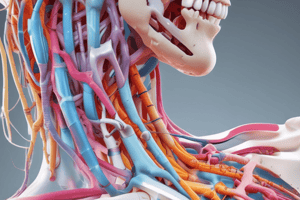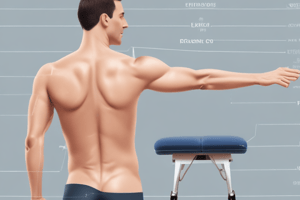Podcast
Questions and Answers
What is the aim of the posterior drawer test?
What is the aim of the posterior drawer test?
- To assess the integrity of the lateral collateral ligament
- To assess the integrity of the medial collateral ligament
- To assess the integrity of the anterior cruciate ligament
- To assess the integrity of the posterior cruciate ligament (correct)
In the posterior drawer test, how is the patient positioned?
In the posterior drawer test, how is the patient positioned?
- Lateral decubitus with hip flexed to 45 degrees and knee flexed to 90 degrees
- Supine lying with hip flexed to 45 degrees and knee flexed to 90 degrees (correct)
- Sitting with hip flexed to 45 degrees and knee flexed to 90 degrees
- Prone lying with hip flexed to 45 degrees and knee flexed to 90 degrees
What is the purpose of the therapist sitting on the patient’s toes during the posterior drawer test?
What is the purpose of the therapist sitting on the patient’s toes during the posterior drawer test?
- To apply posterior force to the tibia
- To stabilize the patient (correct)
- To apply anterior force to the tibia
- To grasp the proximal leg
What is a positive sign of the posterior drawer test?
What is a positive sign of the posterior drawer test?
What type of test is the Valgus & Varus Stress test?
What type of test is the Valgus & Varus Stress test?
Which joint is assessed by the Apley’s test?
Which joint is assessed by the Apley’s test?
What is the primary purpose of the Thomas test?
What is the primary purpose of the Thomas test?
Which of the following tests is used to assess the ankle joint?
Which of the following tests is used to assess the ankle joint?
In the posterior drawer test, what force is applied to the tibia?
In the posterior drawer test, what force is applied to the tibia?
Which test is used to assess the integrity of the posterior cruciate ligament?
Which test is used to assess the integrity of the posterior cruciate ligament?
In which position is the patient placed during the posterior drawer test?
In which position is the patient placed during the posterior drawer test?
What is the purpose of the therapist grasping the proximal leg during the posterior drawer test?
What is the purpose of the therapist grasping the proximal leg during the posterior drawer test?
Which test is used to assess the ankle joint?
Which test is used to assess the ankle joint?
What is the purpose of the FABER/Patrick test?
What is the purpose of the FABER/Patrick test?
Which test is used to assess the hamstring?
Which test is used to assess the hamstring?
What is the purpose of the Ely test?
What is the purpose of the Ely test?
Flashcards are hidden until you start studying
Study Notes
Posterior Drawer Test
- Aims to assess the integrity of the posterior cruciate ligament (PCL).
- Patient is positioned supine with knees flexed to 90 degrees and feet flat on the table.
- Therapist sits on the patient's toes to stabilize the lower leg and prevent movement during testing.
- A positive sign indicates excessive posterior translation of the tibia relative to the femur, suggesting PCL injury.
- The applied force is a posterior force on the tibia to assess PCL stability.
- Therapist grasps the proximal leg to ensure correct positioning and control of movement during the test.
Valgus & Varus Stress Test
- This test assesses the stability of the medial and lateral collateral ligaments, respectively.
Apley’s Test
- Assesses the integrity of the knee joint, specifically for meniscus tears.
Thomas Test
- Primarily used to assess hip flexor tightness, specifically the iliopsoas muscle.
Ankle Joint Tests
- The anterior drawer test and the talar tilt test are commonly utilized to assess the ankle joint.
FABER/Patrick Test
- Used to determine hip or sacroiliac joint dysfunction or pathology.
Hamstring Assessment
- The straight leg raise test is often employed to evaluate hamstring flexibility and tightness.
Ely Test
- Assesses rectus femoris tightness, particularly the ability of the knee to flex while the hip is held in extension.
Studying That Suits You
Use AI to generate personalized quizzes and flashcards to suit your learning preferences.




